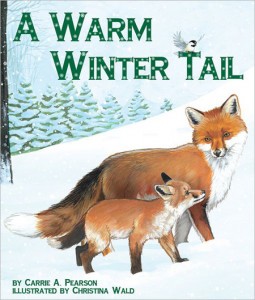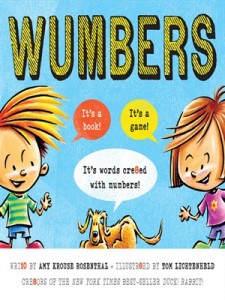A Warm Winter Tail
 Here’s what you need this chilly January: A Warm Winter Tail by Carrie A. Pearson and illustrated by Christina Wald!
Here’s what you need this chilly January: A Warm Winter Tail by Carrie A. Pearson and illustrated by Christina Wald!
This nonfiction picture book about animal adaptations in winter is perfect for a Range of Reading lesson (Core Standard #1 – check!). Carrie Pearson, a Michigander who knows all about staying warm in winter, uses a conversational tone to share a great deal of information. On each double-spread, kids learn what an animal does to stay warm in the winter when a baby animal wonders if humans do what they do to stay warm. For example, a baby box turtle asks its parent if humans dig deep into the mud and bury themselves like it does. A white-tailed deer asks, “Do they grow hollow hair/ so the coats that they wear/ trap the heat from their bodies for warmth?” A wide variety of animals is presented, and there’s plenty of extra information at the back of the book.
On their website, the publisher, Sylvan Dell, has an avalanche of free activities to go with the book (don’t you love not needing to recreate the wheel?) In the back of A Warm Winter Tail there’s a “Winter Animal Matching Activity” where students match the description with the correct animal, and if you go to sylvandellpublishing.com you can print off the animal sorting cards to make a fun independent/pairs/center activity. (Key Ideas & Details – Core Standard #2!) I can’t wait until February when a companion book, A Cool Summer Tail, comes out. Integrating Knowledge & Ideas – Standard #3!
For more information about the author, please visit: carriepearsonbooks.com.
For more information about the illustrator, please visit: christinawald.blogspot.com.
Read MoreWumbers
 “What do you get when you combine a word with a number? A wumber!” Wumbers is wri10 by Amy Krouse Rosenthal and illustr8ed by Tom Lichtenheld, the dynamic duo who made Duck! Rabbit! and other books I love passion8ly. With Wumbers, kids have 2 pay at10tion to the sound of the number word to figure out how to read the wumber. 1ce your students get the gist of it, they’ll want 2 make up wumbers of their own!
“What do you get when you combine a word with a number? A wumber!” Wumbers is wri10 by Amy Krouse Rosenthal and illustr8ed by Tom Lichtenheld, the dynamic duo who made Duck! Rabbit! and other books I love passion8ly. With Wumbers, kids have 2 pay at10tion to the sound of the number word to figure out how to read the wumber. 1ce your students get the gist of it, they’ll want 2 make up wumbers of their own!
Because Wumbers focuses kids’ attention on the small sounds in words, it’s an ideal book to hit the CCSS of Phonological Awareness. Distinguishing the numbers from the letters in the words is part of Print Concepts. 1 book for 2 standards = gr8ful teacher and 4tunate students!
As you read Wumbers to your students, call at10tion first to the way the wumber looks. What number is mixed with letters to make a new word? 1ce students identify the number, say it out loud a few times, then blend the number name with the other letters slowly. Let kids have the thrill of calling out the wumber. It7ly! (Get it – it’s heavenly? Ok, I’m still working on a good one for 7.)
Before you let your students loose on reading and writing wumbers on their own, practice as a group. Choose a number, an easy one like 2 or 4 (because obviously 7 will pose challenges, even for those of us with plenty of wumber po10tial.) Write the number word and any phonological variations: 2 is two, to, too, tu, etc. Now, see if you can come up with words that have that to-tu sound in them. Tuba becomes 2ba. Toothbrush becomes a 2thbrush. Because she is genius, Amy Krouse Rosenthal has a free activities kit available through her website: whoisamy.com. If you and your students come up with some 1derful wumbers, email me! 2gether we will celebr8 Wumbers!
For more about the illustrator, please visit tomlichtenheld.com.
Read MorePeace
 It has been twelve years since the terror attacks on 9/11. Most of the students in elementary classrooms today weren’t even born yet in 2001, so how do we commemorate that day with kids? The kindest way I can think of to honor the lives that were lost is to promote peace, and the most beautiful book I know about peace is this one.
It has been twelve years since the terror attacks on 9/11. Most of the students in elementary classrooms today weren’t even born yet in 2001, so how do we commemorate that day with kids? The kindest way I can think of to honor the lives that were lost is to promote peace, and the most beautiful book I know about peace is this one.
Peace by Wendy Anderson Halperin combines art, poetry, and quotes to help answer the question “how do we make a peaceful world?” The book is quiet and thoughtful, with detailed pictures your students will want to spend time examining close up. You can read aloud the main thread of the poem, which begins with
“For there to be peace in the world…/ …there must be peace in nations./ For there to be peace in nations, there must be peace in cities.”
and then take time to read all the beautiful quotes threaded throughout.
“It’s not so much the journey that’s important, as the way we treat those we encounter and those around us, along the way.” – Jeremy Aldana
Wendy Anderson Halperin has a beautiful website that extends the book: drawingchildrenintopeace.com. She has cool videos where she teaches kids how to draw different peace symbols and she talks about conflict resolution. You can even browse through a gallery of art where kids have drawn and written what peace means to them.
I hope you share Peace with your students. I hope you take time to discuss some of the beautiful quotes, not just because it works for Range of Reading and Craft & Structure, but because they may plant hopeful seeds in your students. If your students choose a quote to illustrate, or write a peace quote of their own and add pictures, you can send it to Wendy Halperin, and send it to me, too. I am all about sharing peace.
For more information about the author/illustrator, please visit wendyhalperin.com.
Read MoreWords with Wings
This novel-in-verse is for the daydreamers and for the teachers who want to guide, not squash, those who have such vivid imaginations.
Words with Wings by Nikki Grimes is one of those gorgeously-written books you can read aloud to your class for wonderful group discussions and then watch them eagerly grab it to read independently. (Novels-in-verse are not only a great way to immerse your students in poetry, but it hits both Range of Reading and Fluency for Core Standards. Woohoo!) Imagine yourself reading aloud this page to your students and knowing that for some kids, it will hit home:
First Day
I duck down in the seat
of my new class.
To these kids,
I’m not Gabby yet.
I’m just Shy Girl
Who Lives
Inside Her Head.
No one even knocks
on the door
for a visit.
They don’t know
it’s beautiful
in here.
Gabby is a daydreamer, which sometimes causes problems in school and at home. But how can she help daydreaming, when words have wings? Some of the poems would make for great writing prompts in your classroom, like this one:
Waterfall
Say “waterfall”
and the dreary winter rain
outside my classroom window
turns to liquid thunder,
pounding into a clear pool
miles below,
and I can’t wait
to dive in.
To my absolute delight, Nikki Grimes named the teacher in this book Mr. Spicer after one of the coolest teachers I’ve ever meet, Ed Spicer. He teaches first grade here in Michigan and he is committed to giving his students time to daydream. Sometimes he plays music, sometimes it’s quiet. Sometimes he asks his students to write about their daydreams, or turn and talk about them, or daydream on a particular topic, like a science concept they are studying. I love the power of daydreaming and I adore Ed Spicer for encouraging his students to take a few moments to let their minds wander. Follow him on Facebook for more about his classroom because he is a wealth of amazing ideas.
So share Words with Wings with your students. For a quick Craft & Structure lesson, talk about the words Nikki Grimes chose that have “wings” for Gabby. Why did she choose these words? What words have wings for you? Give your students a few minutes just to daydream, wonder and imagine. It may become a favorite break in your classroom.
Happy September, everyone!
For more information about the author, please visit: nikkigrimes.com.
Read More







